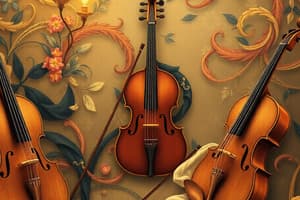Podcast
Questions and Answers
Which instrument family produces sound through the vibration of air inside the instrument and the player's lip tension?
Which instrument family produces sound through the vibration of air inside the instrument and the player's lip tension?
- String
- Percussion
- Woodwind
- Brass (correct)
Which percussion instrument provides a powerful, resonant foundation to the orchestra's sound?
Which percussion instrument provides a powerful, resonant foundation to the orchestra's sound?
- Cymbals
- Triangle
- Snare drum
- Bass drum (correct)
Which woodwind instrument is described as having a warm, full tone that adds depth to the woodwind section?
Which woodwind instrument is described as having a warm, full tone that adds depth to the woodwind section?
- Flute
- Clarinet
- Oboe
- Bassoon (correct)
Which family of instruments produces sound through the vibration of air inside the instrument?
Which family of instruments produces sound through the vibration of air inside the instrument?
Which brass instrument is described as the largest and lowest-pitched in the brass family?
Which brass instrument is described as the largest and lowest-pitched in the brass family?
Which percussion instrument is known for adding variety and color to the orchestra's sound?
Which percussion instrument is known for adding variety and color to the orchestra's sound?
Which instrument in the string section provides a rich, warm tone to the ensemble?
Which instrument in the string section provides a rich, warm tone to the ensemble?
What is the function of woodwind instruments in an orchestra?
What is the function of woodwind instruments in an orchestra?
Which woodwind instrument produces a bright, clear tone in the orchestra?
Which woodwind instrument produces a bright, clear tone in the orchestra?
What is the role of the double bass in an orchestra?
What is the role of the double bass in an orchestra?
Which string instrument is the smallest and highest-pitched in the orchestra?
Which string instrument is the smallest and highest-pitched in the orchestra?
What aspect of an orchestra does percussion instruments contribute to?
What aspect of an orchestra does percussion instruments contribute to?
Flashcards are hidden until you start studying
Study Notes
Orchestral Instruments Assessment
As a symphony orchestra embarks on a musical journey, the quality and balance of its sound relies on the diverse palette of instruments that make up the ensemble. In this exploration, we'll delve into the world of these instruments, illuminating the aspects that make each class unique and valuable to the orchestra's repertoire.
String Instruments
String instruments are the backbone of the orchestra, providing warmth and richness to its sound. This class consists of:
- Violin: The smallest and highest-pitched instrument in the string section, the violin delivers a sweet and lyrical tone.
- Viola: Slightly larger and deeper in sound than the violin, the viola adds a rich, warm tone to the ensemble.
- Cello: The deepest-sounding instrument in the string section, the cello's lush, resonant tone enhances the orchestra's low end.
- Double Bass: The largest and lowest-pitched string instrument, the double bass provides the foundation for the string section's sound.
Strings produce sound by the vibration of their strings, which are plucked or bowed by the performer.
Woodwind Instruments
Woodwind instruments introduce color and clarity to the orchestra, providing a vibrant and agile presence. The woodwind family includes:
- Flute: Producing a bright, clear tone, the flute contributes a delicate, airy sound to the ensemble.
- Oboe: The oboe is the closest in sound to the human voice, offering a warm, mellow tone.
- Clarinet: Available in B♭, A, or E♭, the clarinet produces a bright, clear sound that's well-suited for melody lines.
- Bassoon: The bassoon's warm, full tone adds depth to the woodwind section, while its versatile range is well-suited for both melody and accompaniment.
Woodwinds produce sound through the vibration of air inside the instrument.
Percussion Instruments
Percussion instruments bring rhythm and excitement to the orchestra, adding a rich tapestry of textures to the ensemble. In a general orchestra, you might find:
- Snare drum: A crisp, snappy sound that adds drive and energy to the music.
- Bass drum: Producing a deep, resonant tone, the bass drum supports the snare drum and provides a strong beat.
- Cymbals: Ranging from soft and delicate to loud and bright, cymbals add variety and color to the orchestra's sound.
- Timpani: These massive, tunable drums provide a powerful, resonant foundation to the orchestra's sound.
- Triangle: A high-pitched instrument that adds clarity and shimmer to the ensemble.
Percussion instruments produce sound when struck or shaken.
Brass Instruments
Brass instruments bring brilliance and power to the orchestra, adding depth and volume to the ensemble. The brass family includes:
- Trumpet: Producing a bright, clear sound, the trumpet adds excitement to melodies and harmonies.
- Horn: A warm, mellow tone that adds depth and richness to the brass section.
- Trombone: Available in tenor, bass, or bass-tenor versions, the trombone produces a warm, rich tone that can blend well with other instruments.
- Baritone: A large brass instrument that provides a deep, resonant tone to the brass section.
- Tuba: The largest and lowest-pitched brass instrument, the tuba adds depth and volume to the ensemble's sound.
Brass instruments produce sound through the vibration of air inside the instrument and the player's lip tension.
Each instrument class brings unique qualities to the orchestra that enhance the musical experience. Understanding these characteristics helps musicians and listeners connect with the music in a more meaningful way. By assessing the orchestra's instruments, we gain a deeper appreciation for the complexity and nuance that these instruments contribute to symphonic music.
Studying That Suits You
Use AI to generate personalized quizzes and flashcards to suit your learning preferences.




